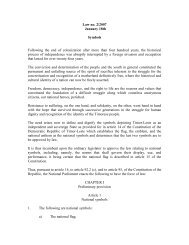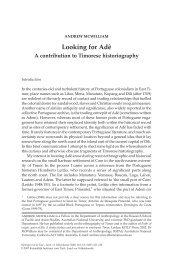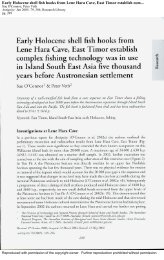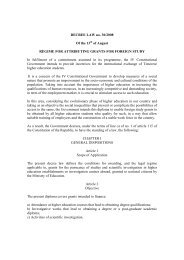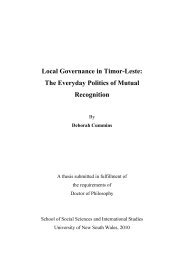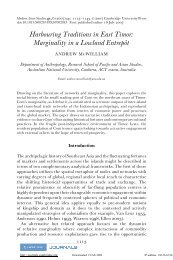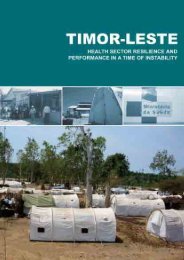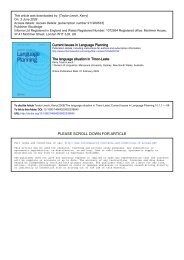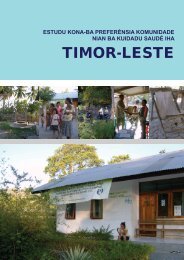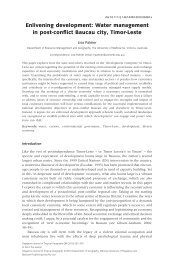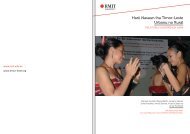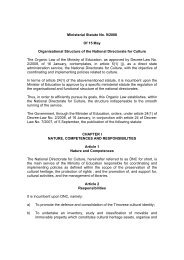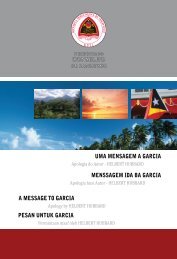Satisfaction with services was difficult to assess, especially in settings where the features of ‘goodquality’ services have not been articulated [40]. The range of studies on HIV were not reviewed.On the theoretical si<strong>de</strong>, research into health care seeking has been criticised as being a “somewhatover-utilised and un<strong>de</strong>r-theorised tool” [42]. Despite this there is an abundance of mo<strong>de</strong>ls andapproaches on which to draw. Some authors [40, 41] have called for caution, noting the ten<strong>de</strong>ncy formo<strong>de</strong>ls to focus too heavily on individual level characteristics in explaining behaviour, rather thanconsi<strong>de</strong>ring the broa<strong>de</strong>r picture. Hausmann-Mueler et al. [43] suggest that behind many mo<strong>de</strong>ls is anassumption that individuals make rational <strong>de</strong>cisions to maximise utility and do not take into accountemotional aspects, the symbolic value of actions, political forces, or social and cultural relations. Keyfactors i<strong>de</strong>ntified are often consi<strong>de</strong>red in isolation from the context in which they occur, even forsimple but important issues such as perception of severity of malaria being worse in some seasons.Similarly, MacKian [42] argues that to un<strong>de</strong>rstand health seeking it is necessary to go beyond theindividual and explore further the way the “local dynamics of communities” influence the process.This requires addressing two often neglected issues: the collective element of health seekingbehaviour, and the interaction between individual and societies and health systems. The HCSBS drewon these i<strong>de</strong>as, together with a broad conceptual mo<strong>de</strong>l <strong>de</strong>veloped by Kroeger, cited in [43], whichhas influenced several studies in other <strong>de</strong>veloping countries.2.2 – <strong>Timor</strong>-<strong>Leste</strong> studies and reportsA range of <strong>de</strong>velopment partners in <strong>Timor</strong>-<strong>Leste</strong>, including NGOs and UN agencies, provi<strong>de</strong>d reportson research they had done around health care seeking. In some geographical areas there has beenextensive work focusing on specific health topics, such as child health practices, reproductive healthand nutrition. Both HAI and TAIS, for example, have produced very <strong>de</strong>tailed reports that shed lighton health beliefs and practices related to maternal and child health, while UNFPA has conducted asituation analysis and qualitative research on reproductive health. In this section, we summariseonly those studies that report on health care seeking in general. 2<strong>Timor</strong>-<strong>Leste</strong> <strong>Health</strong> <strong>Care</strong> <strong>Seeking</strong> <strong>Behaviour</strong> <strong>Study</strong> | 200917The 2003 DHS inclu<strong>de</strong>d several aspects of health-seeking behaviour, summarised by TAIS [19].Approximately 1 in 10 households reported not using any health care provi<strong>de</strong>r when a householdmember was ill. Curative health care encounters occurred predominantly in community healthcentres (58.9%), about a quarter (24.6%) occurred in government hospitals, and 11.4% occurred inprivate clinics. Some people bypassed their community health centre and sought care at the nearesthospital instead. Mean travel time to the usual first health care provi<strong>de</strong>r was 35 minutes, with travelmostly by walking. Ever-married women who reported “big problems” in accessing health care forthemselves i<strong>de</strong>ntified the following difficulties: distance to health facility (63.6%), having to taketransport (62.2%), not wanting to go alone (61.7%), getting money for treatment (59.3%), knowingwhere to go (26.7%), getting permission to go (17.9%), and concern about the absence of a femaleprovi<strong>de</strong>r (4.4%). One or more of these specified reasons was reported by 75.9% of respon<strong>de</strong>nts.In 2005 the World Bank fun<strong>de</strong>d a qualitative study [7] that incorporated focus groups with healthservice workers and users, and in-<strong>de</strong>pth individual interviews, across 5 sub-districts. The studyexplored health care seeking behaviour, barriers to service utilisation and human resource issues.The major barriers to utilisation were found to be socio-cultural knowledge and practices, servicequality issues and geographical distance. In addition, it was found that systems of ethnomedicine2 A summary of all <strong>Timor</strong>-<strong>Leste</strong> information on health care seeking collected (research findings and personal andorganisational insights) is available on request.
played a major role in health care seeking, with people tending to use traditional and biomedicalhealth systems interchangeably.A review of <strong>Timor</strong>-<strong>Leste</strong> literature from 2002–2006 conducted by TAIS (19) i<strong>de</strong>ntified several crosscuttingissues that have the potential to negatively impact on use of health services and generalhealth improvement. Service and service-quality issues inclu<strong>de</strong>d lack of running water and/orelectricity, poor communication systems (with many facilities having no on-site radio), limitedavailability of drugs, lack of transport attached to most facilities (and low fuel budgets for those thatdo have it), and travel often hampered by heavy rains. Community factors inclu<strong>de</strong>d a general lack ofun<strong>de</strong>rstanding of the need for health care, a mistrust of services and strong beliefs in traditionalmedicine. Among the barriers to health improvement were damming of groundwater and sewerdrainage to grow vegetables leading to proliferation of mosquitoes, and coffee cultivation taking theplace of subsistence farming contributing to malnutrition. Barriers to the use of health facilities forsafe <strong>de</strong>livery inclu<strong>de</strong>d lack of private space and resources nee<strong>de</strong>d to carry out traditional practicesaround childbirth.Section 3 – Methods3.1 Design and approachThe HCSBS employed a mixed methods research <strong>de</strong>sign and involved field work in all 13 districts of<strong>Timor</strong>-<strong>Leste</strong>. In addition to a household survey, in-<strong>de</strong>pth interviews were conducted with villageheads and health service provi<strong>de</strong>rs and users, and focus group discussions (FGDs) were held withcommunity members.3.1.1 SurveySampling: TLSLSThe TLSLS used the 2004 Census Enumeration Areas (EAs; total of 1,163) as a national samplingframe. The TLSLS aimed to represent the population of <strong>Timor</strong>-<strong>Leste</strong> and therefore sampled acombination of rural and urban areas from across the country. The country was divi<strong>de</strong>d into 5regions (by including a certain number of the 13 districts in each region) and each region into 2 strata(urban and rural). Nationally, therefore, there were 10 strata, from which 300 EAs in total wereselected using probability proportional to size sampling. Within each EA 15 households wererandomly selected, producing a total of 4500 households in the cross-sectional sample of TLSLS.Sampling: HCSBS SurveyThe HCSBS survey drew a sub-sample from the TLSLS sample. As there was interest in equalrepresentation from all 13 districts when investigating health-care seeking, the HCSBS survey samplewas stratified by district. The 300 TLSLS EAs were taken as the sampling frame and three EAs wererandomly selected from each district. The sample was <strong>de</strong>signed to be typical of rural areas withoutaccess to hospitals, therefore EAs that inclu<strong>de</strong>d a hospital were exclu<strong>de</strong>d. To avoid respon<strong>de</strong>ntfatigue we also exclu<strong>de</strong>d those that had been inclu<strong>de</strong>d in the 2008 TLSLS Extension survey. In eachof the selected EAs, the 15 households originally surveyed in the TLSLS were re-approached for theHCSBS, allowing data linkage. In all, the HCSBS survey target sample comprised of 39 EAs and 585<strong>Timor</strong>-<strong>Leste</strong> <strong>Health</strong> <strong>Care</strong> <strong>Seeking</strong> <strong>Behaviour</strong> <strong>Study</strong> | 200918



